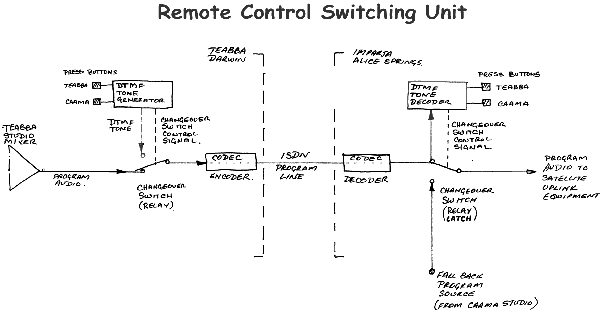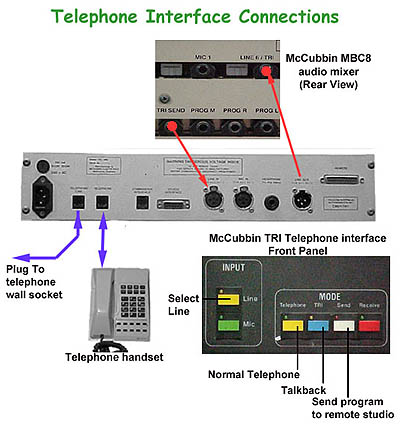|
As far back as late 1992, there were discussions on
how to set up links to Alice Springs to take advantage
of the offer by IMPARJA for TEABBA to make use of a
spare audio channel on their transponder (OPTUS B1).
To
get the program to IMPARJA in Alice Springs, two options
were looked at by management:
- a
program line or
- an
ISDN circuit.
As
TEABBA was operating on a limited budget, both proposals
were considered too expensive at the time, consequently
the network idea was put on hold until more funds could
be obtained to purchase the equipment needed.
The
Board were still keen to get a network operating initially
from the Darwin studio, then later linking the community
stations (BRACS) into the network.
Revisiting
the options available to them ISDN was again ruled as
being too expensive; TEABBA did not have the capital
required to purchase the ISDN interface units. TEABBA
proceeded with the only other option available - a 10khz
mono landline between Darwin and the IMPARJA uplink
point at Alice Springs.
The
connection was finally made and coincided with the move
to the new Darwin studios. The first broadcast into
the TEABBA satellite radio network took place on the
7th July 1994.
With
the main connection for the network up and running,
the next problem was how to fill the channel with program.
TEABBA could only provide limited output due to low
staff numbers. Broadcasting was limited to morning programs
and community stations were not as yet connected so
the other alternative was to use program from CAAMA
radio studios and feed it into the satellite channel
when TEABBA was unable to provide program.
Remote
switching
To make this connection, remote switching at the IMPARJA
uplink feed point had to be achieved from the Darwin
studio. Evan Wyatt designed and constructed a simple
dual tone multi-frequency (DTMF) transmitter and receiving
unit especially for this purpose. The principle was
simple, when CAAMA program was required to feed into
the satellite channel:
- the
Darwin operator would press the changeover button
- the
studio output program was cut
- DTMF
tones were then sent down the program line, picked
up by the receiving unit at IMPARJA
- the
tones were decoded and the appropriate latching relay
would be activated to direct either TEABBA or CAAMA
program into the satellite channel.
The
inconvenience of having the tones broadcast (1/2 second)
far outweighed the cost of having a separate control
line from Darwin to Alice Springs.
When
these decisions were made, there were plans to revisit
the shortcomings in the system. When more funds became
available to purchase ISDN equipment, and when a higher
level of program output from the Darwin studio was achieved,
the need for remote switching and supplementing the
program with that from CAAMA would be eliminated.

Remote control switching diagram. Courtesy:
TEABBA.
Studio
program links
The next step in setting up the network was to connect
the community radio stations into the network. After
initial discussions with Telstra it became obvious that
10khz or 3khz dedicated program lines would not be available
in most communities, due to capacity limitations of
the existing communications network. It seems Telstra
had not envisaged there would be a demand for permanent
program lines out of a community. In fact quite the
opposite looks set to happen, with the emergence of
more community based broadcasters recognising the need
to network.
This
landline approach was abandoned, as the closest TEABBA
could get to a community with a program line was to
a major centre such as Gove in the east Arnhem Land
region, the annual costs were in the vicinity of $20
000.
TEABBA
was confronted with three options:
- do
nothing and wait for line capacity in communities
to be increased
- wait
for new technology to come on the market that could
improve the quality of existing links
- keep
the momentum of enthusiasm running and use dial up
telephone lines as program lines with telephone talkback
units as the temporary program line interfaces, this
arrangement would at least provide 3khz program lines,
which was better than nothing.
TEABBA
decided to go with the third option.
Testing
Two units were purchased, the TRI-MM Telephone Hybrid
unit (TRI) was installed at the Darwin studio end and
the smaller Reporters Telephone Link (RTL) was installed
at Galiwinku community radio station.
*TRI
is short for the McCubbin Electronics TRI-MM Telephone
Hybrid unit. This unit converts the two-wire telephone
connection provided by the Telstra network into a separate
two-wire transmit, and a two-wire receive connection,
suitable for use within the studio.
The
operation was simple:
- a
telephone handset was connected through the telephone
units at both ends
- Darwin
studio would call the community station when contact
was made
- both
ends would then press the transfer button on their
respective interface units
- the
handpiece connection would drop out and the result
is a 3khz broadcast line.
The idea worked well and is still in use today, with
not one single complaint of the program quality.

Temporary program line interface.
Photo: Evan Wyatt. Courtesy: TEABBA
|
First
network broadcast
After these initial tests proved that the system could
work, arrangements were made with Galiwinku community
BRACS station to commence broadcasting through the network
on 7th July 1994. The broadcaster was Frank Djirrimbilpilwuy,
significant in that he was the founding chairman of
TEABBA.
Equipment
used for this initial broadcast was not the sort of
stuff big networks are made from, it comprised:
- a
simple 4 channel mini audio mixer
- a
hand held microphone and two tape decks.
The
output was fed into the telephone interface for transmission
over the satellite network via the Darwin studio.

Typical interface connections and equipment.
Courtesy: TEABBA
Activity
1. Draw a flowchart to illustrate the remote switching
using DTMF designed by Evan Wyatt.
2. Draw a diagram to illustrate the operation of dial
up telephone links as program lines.
|